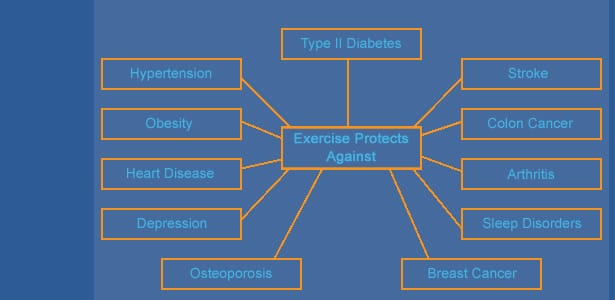A healthy organisation prioritises the well-being of its employees and provides a supportive work environment that encourages healthy habits and activities. Creating a healthy workplace requires a holistic approach that considers the physical, mental, and emotional well-being of employees.
Preventive measures such as regular exercise, risk factor reduction, and early detection and treatment of illnesses can help reduce absenteeism and presenteeism. Employee Wellness Programs have been proven effective in reducing absenteeism and injury in the workplace, as well as improving employee morale, productivity, and retention rates.
In addition, a healthy lifestyle through regular exercise can boost productivity and enhance an employee’s self-image and positive outlook on life, while reducing the risk of chronic illnesses and diseases.
Let’s explore what employers in Australia can do to create healthy workplaces, to the benefit of employees across the country along with the organisations they work for.
How Healthy is Your Workplace?
Within Australia, we are only just beginning to recognise the impact that a “sick workforce” can have on employers and employees. A study conducted by Morgan and Banks found that sick leave was costing Australian businesses $2.56 billion a year and that 2.7% of the Australian workforce was absent on unapproved leave on an average day.
Research by Direct Health Solutions into employee absence in Australia reveals the following:
- Australians are taking over 80 million sick leave days per annum!
- The average direct salary cost of sickness absence in Australia is over $2,000 per employee per annum.
- The cost of absenteeism has risen over 25% since 2000.
- 85% of organisations are experiencing an increase in sick leave.
- Over 60% of organisations do not know and measure the cause and cost of absence.
- An article entitled Absence Management in the Land of the Long Weekend supports these figures. 12.4% of people surveyed in the Morgan & Banks research admitted that none of the sickies they had taken in the previous year had been for genuine reasons. 67% preferred to take a sickie on a Monday and 25% chose a Friday because it gave them a long weekend.
Absenteeism is Preventable
The causes that lead to employee absenteeism, presenteeism (which is estimated to cost the economy $34 billion a year), losses of productivity, low morale and job dissatisfaction can be prevented through better lifestyle patterns. Health researchers have highlighted the fact that physical activity can play a part as a preventative factor in seven of the ten health issues identified by Direct Health Solutions in their 2006 survey of reasons for absenteeism.
Today, research relating to the health benefits of regular moderate exercise and the health dangers of sedentary living, is following the same critical path as did past research relating to smoking. Hardly a month passes without publication of yet another study documenting exercise’s protective effects on an ever-widening spectrum of chronic illnesses and conditions.

What is Sickness Prevention?
Sickness prevention is applying the necessary processes or patterns in our daily lives to empower people to gain greater control over decisions and subsequent actions affecting their health and wellbeing.
Sickness prevention covers measures not only to prevent the occurrence of disease, such as risk factor reduction, but also to arrest its progress and reduce its consequences. Programs that emphasize PREVENTION, early DETECTION and early TREATMENT, reduce the impact of many preventable diseases and injuries that lead to absenteeism in the workplace.
For over a decade, research has been showing the effectiveness of Employee Wellness Programs in reducing employee absenteeism and injury in the workplace. For every dollar spent on a Corporate Wellness Program, the returns have been cost savings of between $2.30 and $10.10 in the areas of decreased absenteeism, fewer sick days, reduced Work cover claims and improvements to employee performance and productivity.
Wellness programs can also help alleviate depression and help employees manage their time and stress levels better, all of which are contributing factors to missed workdays. Additionally, a healthy organisation increases employee morale, improves the ability to attract and retain key people, all while having more alert and productive employees. Some statistics of note:
Return on Invesment
- Bank of America realized a return of $6 for every $1 spent on its health-promotion program. – American Journal of Health Promotion
- PepsiCo found that its corporate fitness program produced a 300% ROI. – Fitness Systems New York
- Telephone saw a return of $1.95 for every $1 spent on corporate fitness. – Compensation and Benefits Management
Reduced Employee Turnover
- Tenneco found that employees who participated in its corporate fitness program were 13% less likely to leave the company than those who did not. – Business and Health
- Toronto Life Assurance reported that turnover of employees in the wellness program was 1.5%, versus 15% for non-participants. – Economic Benefits of Enhanced Fitness, Roy Shepherd
- The Association of Occupational Health Nurses found that 60% of employees consider wellness programs an incentive that greatly added to their decision to remain with their current employer.
- 74% of workers believe wellness benefits encourage them to work harder and even perform better. 48% believe wellness offerings would encourage them to stay in their current position. – 2006 Principal Financial Well-Being Index
Reduced Absenteeism
- Northern Gas Company employees who are in the corporate wellness program use 80% fewer sick days than non-exercising employees. –Riverside Occupation Health Services
- Coors has saved over $2.3 million in lost wages due to absenteeism. –Business & Health
- Johnson and Johnson watched its absenteeism rate fall by 15% within two years of introducing a fitness program. –Human Resources Executive
- Control Data Corporation estimates it has reduced costs of absenteeism by $1.8 million annually through implementation of its StayWell Program.
A healthy lifestyle impacts every part of an employees day-to-day work environment. Corporate Wellness Programs translate into fewer injuries, less human error, and a more harmonious working environment. They also let the employee know that the organisation is concerned about their general health and well-being.
Exercise: An Energy Enhancer

Regular physical activity is not only good for your body, it’s good for your mind and spirit too. Productivity is boosted because of the individual benefits of exercise, including:
- An enhanced self-image and a more positive outlook on life.
- Regardless of what kind of shape you are in or how old you are, exercise helps keep you feeling younger, happier and healthier.
- Studies show that regular physical activity elevates mood and increases creativity and alertness.
- One of the greatest benefits of exercise is that it strengthens your heart and its ability to pump oxygenated blood to the body. Increasing the amount of oxygen supplied to the brain reduces anxiety and stress, helps fight depression and improves memory. It also causes the brain to release endorphins, or `feel good’ chemicals, that make you feel calmer and better equipped to handle stressful situations.
Your Programs?
Build a healthy workforce for your company. Prevention really is better than cure.










Leave a Reply